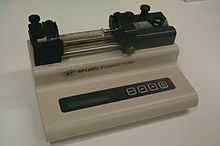Syringe driver

A syringe driver or syringe pump is a small infusion pump (some include infuse and withdraw capability), used to gradually administer small amounts of fluid (with or without medication) to a patient or for use in chemical and biomedical research.
The most popular use of syringe drivers is in palliative care, to continuously administer analgesics (painkillers), antiemetics (medication to suppress nausea and vomiting) and other drugs. This prevents periods during which medication levels in the blood are too high or too low, and avoids the use of multiple tablets (especially in people who have difficulty swallowing). As the medication is administered subcutaneously, the area for administration is practically limitless, although edema may interfere with the action of some drugs.

Syringe drivers are also useful for delivering IV medications over several minutes. In the case of a medication which should be slowly pushed in over the course of several minutes, this device saves staff time and reduces errors.
Syringe pumps are also useful in microfluidic applications, such as microreactor design and testing, and also in chemistry for slow incorporation of a fixed volume of fluid into a solution. In enzyme kinetics syringe drivers can be used to observe rapid kinetics as part of a stopped flow apparatus.[1] They are also sometimes used as laboratory media dispensers.
References
External links
| Wikimedia Commons has media related to Syringe drivers. |